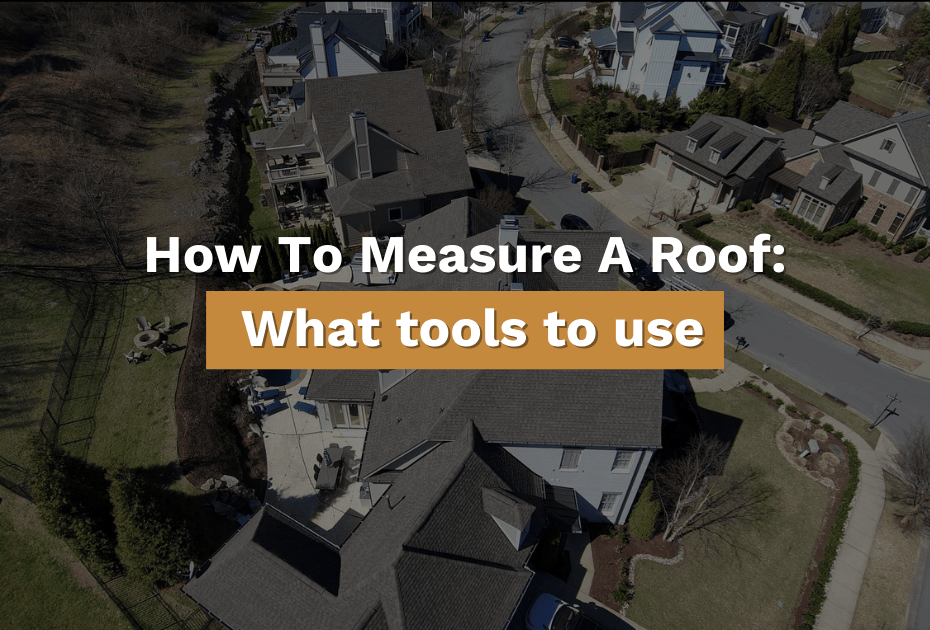
Highlights for Measuring a Roof
Measuring a roof can be done safely from the ground with the right tools and techniques. Understanding roofing squares, pitch, and roof types is essential. Use a tape measure, graph paper, and a roofing calculator to determine square footage and material needs accurately. This method minimizes risks while ensuring precise material estimates.
Table of Contents
How To Measure A Roof
Do you know how it's done?
Measuring a roof from the ground can be a much safer way to get the information you need to do a roof. The basic idea of measuring a roof from the ground may sound ridiculous, but it can be done and done very accurately. The roof deck, which serves as the base for roofing materials, is a critical component that supports the roof's protective layers. Everyone should measure at least the perimeters of the roof from the ground because the risk of a fall can be avoided. These tips can reduce the risk of a fall. This web page shows how the roof can be measured from the ground and an order for materials to be placed.
Understanding Roofing Basics
Before diving into the specifics of measuring a roof, it's crucial to understand some basic roofing concepts. Knowing these fundamentals will simplify the measuring process and help you communicate effectively with roofing contractors or suppliers.
What is a Roofing Square?
A roofing square is a standard unit of measurement in the roofing industry. It is equivalent to 100 square feet of roof surface and calculates the amount of roofing materials needed for a project. This measurement is essential for determining the number of roofing shingles, underlayments, and other materials required for your new roof. By understanding roofing squares, you can more accurately estimate the materials needed, ensuring you order the right amount and avoid unnecessary waste.
Types of Roofs
Roofs come in various shapes and designs, each with its unique characteristics and requirements. Some common types include gable roofs, hipped roofs, and flat roofs. A gable roof, for instance, features two slopes that meet at a central ridge, forming a triangular shape. This design is one of the most common and is known for its simplicity and effectiveness in shedding water and snow. A simple gable roof is a basic version of this design, with a single ridge and two slopes, making it straightforward to measure and work with. Understanding your roof type is essential for accurate measurements and material calculations.
What Tools Do I Need to Measure a Roof?
To measure a roof accurately, you'll need a few essential tools. A tape measure is a must-have, with an ideal 25-foot or more extended tape. For added speed and precision, consider using a laser measure. Graph paper will help you keep straight lines and scale your roof drawing accurately. A calculator is crucial for handling complex math without errors, and a roofing calculator or app can simplify the process further. A pitch gauge, physical tool, or smartphone app is also necessary to determine the roof's pitch. Understanding roofing terminology and concepts, such as square footage and roof pitch, will also be beneficial.
Measuring Roof Size
Calculating Square Footage
Calculating a roof's square footage involves measuring the length and width of each section and multiplying them together. The total square footage is the sum of the areas of all sections. For example, if a roof has two sections, each measuring 20 feet by 30 feet, the total square footage would be 1,200 square feet (20 x 30 = 600 square feet per section, x 2 sections = 1,200 square feet).
When calculating square footage, it's essential to consider the roof's pitch or slope. A steeper pitch means a larger surface area than what's visible from a bird's-eye view. To adjust for the pitch, use a pitch multiplier, which varies depending on the roof's pitch. This adjustment ensures you account for the actual roof area, providing a more accurate measurement for ordering materials. By following these steps, you can determine the total square footage of your roof, ensuring you have the right materials for your project.
What tools do I need to measure a roof with a roofing calculator?
1. Tape Measure. A 25-foot or longer tape measure works well. Some use a laser for speed, which is very accurate. There are also measuring wheels that work well.
2. Graph Paper: Some basic graph paper will help you keep straight lines and scale your roof drawing. You can use a two-foot scale drawing; most homes will fit on an 8.5 x 11 sheet of paper.
3. A Calculator is an essential tool because it helps you with complex math with few or no errors. A roofing material calculator can also be a valuable tool, helping you determine the size of your roof and estimate the quantity and cost of various roofing materials needed for your project.
4. Pitch Gauge will be needed to find the pitch of a roof. There are pitch gage Apps for smart phone free to download. Familiarize yourself with the names of roof parts, like the Gable, Hip, Valley, Eave, and Ridge. Take a minute before you measure and Google your roof, then highlight these parts of the roof, as seen here to the left. It will help with your drawing later. Start from the left corner and take measurements from the eave to eaves all around the home. Using the graph sheet, you should end up right where you started. If you don't, then you made an error some where.
What now?
Once the site drawing is done, look at the drawing, and, with a red marker, draw out squares like seen in this drawing.
A, Is B, C, and D, Do you see the squares? Add these four totals, and you have the footprint of the roof, which is 1860 sq. ft. Now, we need to add the pitch factor, which is the roof's rise. Most homes have about a 4:12 pitch or 18.5 degrees. This is as low a pitch as you want when installing asphalt shingles. This roof we are measuring today is a 6:12 pitch or 26.5 degrees. The pitch factor I use for this is 1.12. This factor should be times the house footprint, 1860 sq. feet, and your roof size equals 2084 or 20.84 squares. Let's call it 21 squares. Determine the waste factor, and you will have the total roofing sq. You need to complete this roof.
Valleys and Hip Length
The valleys and hip length need to be calculated using the hip factor of 1.50 for a 6:12 pitch. So, here on the front right side is a hip roof, and the width is 24 feet. x 1.50= 36 feet, divided by 2 for each side, which equals 18 feet for the hip length. The valleys are the same formula as the hips. For this short valley on the right being 6 foot equals 6 x 1.50 = 9 ft. The eave should be looked at by a ladder to see how many layers of shingles there are on the roof. You can place a materials order to the supply house with a good roof flashing count. Here are the pitch factors rounded up for calculating the squares of a roof.
Degrees converted to roof pitch
9.5° = 2:12, 14° = 3:12, 18.5° = 4:12, 22.5° = 5:12,
26.5° = 6:12, 30° = 7:12, 33.5° = 8:12, 37° = 9:12,
40° = 10:12, 42.5° = 11:12, 45° = 12:12
Conclusion:
Measuring a roof accurately is crucial for ordering the right amount of materials and ensuring a successful roofing project. While traditional methods involve climbing onto the roof, measuring from the ground is a safer and effective alternative. By understanding key roofing concepts such as roofing squares, pitch, and different roof types, homeowners and contractors can make precise calculations. Using essential tools like a tape measure, graph paper, pitch gauge, and a roofing calculator simplifies the process. Proper measurements help prevent material waste, reduce costs, and ensure the roof is built correctly.




